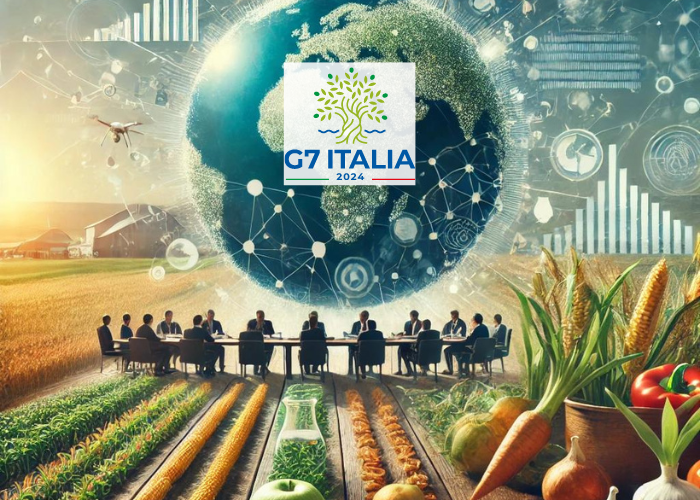Food security calls: the G7 agriculture must respondBY PIETRO PAGANINI
- 24 September 2024
- Posted by: Competere
- Category: Senza categoria

HuffPost recently published a commentary by Pietro Paganini, in which he explores the crucial issue of food security and the need for related challenges to be addressed during the G7 Agriculture Ministers’ meeting.
You can read the full comment in Italian on HuffPost or the English translation below >>>
As the G7 Agriculture Ministers’ meeting is taking place, we are facing a crucial opportunity to address the pressing challenges of food security. Although it is impossible to solve such complex problems in just a few hours, the leaders are expected to present a clear vision: increasing agricultural productivity and ensuring food security, while balancing social, economic, and environmental needs.
By 2050, the world population will reach 9.7 billion, contributing significantly to an already growing demand for food. To grasp the scale of this problem, between 30 and 80 million more hectares will be needed just to produce the vegetable oils and fats necessary for the anticipated population to have access to a balanced diet—resources that are difficult to find without compromising the environment. The answer lies in improving agricultural productivity, supported by policies that promote investments in technological innovation and efficient management.
Technology is essential for ensuring sustainable productivity: synthetic agriculture, cellular or soilless agriculture, space technology applied to the earth, quantum technology, circular and regenerative agriculture, tailored farming, biofabrication and innovative materials, artificial intelligence, automation, and the Internet of Living Things (IoLT) are just a few of the sectors necessary to develop. Italian companies are already at the forefront, for example, with regenerative livestock farming.
The meat supply chains (beef, pork, and poultry) account for 13% of the Italian agri-food sector, which reached 248 billion euros in 2023 (12% of the national GDP). The value stands at 33 billion euros annually, of which about 22 billion comes from the processing industry and about 11 billion from the agricultural phase. In terms of employment, it involves half a million workers, with 451,000 in livestock farms and 62,000 in the processing industry. There are also 25,000 butcher shops operating in Italy. Despite the importance of these numbers, they are not enough to guarantee the food “sovereignty” sought by the government and, to a lesser extent, by the EU. Currently, Italy imports 60% of the meat consumed. Urbanization has triggered a steady decline in livestock activities, exacerbated by climate change, the rise of the service and information society, and social and anthropological transformations. However, digitization and automation offer the opportunity to significantly increase production capacity, marking a radical change. It is essential to seize this opportunity to effectively address future challenges.
Regenerative livestock farming represents an innovative farming model that integrates ecological, management, and technological principles to create sustainable agricultural systems. This approach promotes ecological diversity, reduces the use of chemicals, and improves animal welfare, while promoting soil regeneration, biodiversity, and carbon sequestration. Practices such as livestock rotation and the use of native plants improve soil health and increase the resilience of agricultural ecosystems.
Advanced technologies play a crucial role in regenerative livestock farming. Precision agriculture, with the use of drones, sensors, and GPS systems, allows for efficient monitoring and management of pastures and livestock. Artificial intelligence and big data optimize pasture rotation, predict animals’ nutritional needs, and monitor their health, reducing the use of antibiotics and improving overall welfare. Additionally, biotechnologies, such as the inoculation of beneficial microorganisms and the use of biofertilizers, enhance soil fertility and ecosystem resilience.
The benefits of regenerative livestock farming are numerous. Environmentally, it improves soil health, increases biodiversity, and contributes to climate change mitigation through carbon sequestration. Economically, it reduces operating costs, increases the resilience of farms, and provides access to premium markets that value sustainability. Socially, it supports rural communities, improves product quality, and promotes greater awareness of sustainability in agriculture.
Italian companies, even medium-sized ones, are already adopting these practices independently, despite the lack of state support and the pressure from environmentalist and animal rights groups intent on boycotting meat consumption. Regenerative livestock farming not only protects ecosystems but also offers long-term economic benefits, such as cost reduction and increased resilience, making food production more sustainable and enduring.
Rather than boycotting meat, it would be more effective to promote balanced and sustainable consumption that respects the environment, animal welfare, and biodiversity. Regenerative livestock farming practices not only protect ecosystems by improving soil health and carbon sequestration but also offer long-term economic benefits: cost reduction, increased resilience, and access to premium markets.
It is essential that the G7 leaders steer policies towards technological innovation and efficient management of agricultural organizations to effectively address the challenges of global food security.
Read African Swine Fever: managing the threat to Italy’s market >>>
